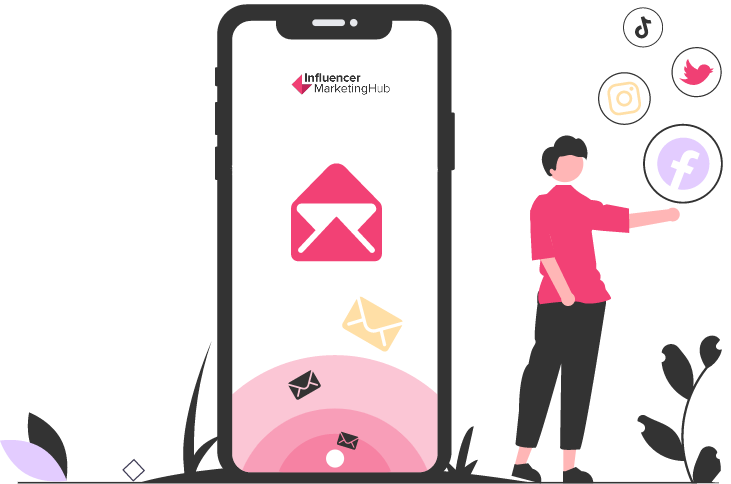How to Host Your Next Virtual Event Successfully (In-Depth Guide)
As technology evolves and internet use becomes even more popular, people are increasingly getting acquainted with doing things virtually. This trend was accelerated when the pandemic drove people indoors and limited us to virtual-only interactions. Even events are taking place online, allowing attendees to participate from halfway around the world.
Now virtual events have become a valuable tool for businesses to engage their communities and market their products. If you’re thinking of leveraging virtual events but aren’t sure where to start, keep reading to find out. We provide you with an in-depth guide on how to host your next virtual event and what types of events you can host. Let’s get started.
An In-Depth Guide to Hosting Your Next Virtual Event Successfully:
What is a Virtual Event?
Virtual events are exactly as the name suggests–they’re events that take place online. It can be anything from an informal AMA session on Reddit to an exclusive invite-only webinar. They take place in real-time through social media platforms or dedicated virtual event platforms and can either be hosted through live videos, voice calls, or social media posts.
Oftentimes with live video events, the host also makes the session available for on-demand viewing after the event has ended. This is a great way to ensure that more people can access the event even if they couldn’t make it to the live session.
Virtual events have rapidly caught on in recent years with more businesses realizing the cost-effectiveness of hosting them. You don’t have to spend money on renting space, figuring out the logistics, and setting up the place. Additionally, they’re an excellent option when you have people who will be attending from different states or from different parts of the world.
However, some people may find the nature of these events impersonal since there’s no physical interaction. Issues with network, background noise, audio or video quality, etc. could also put a damper on the attendee experience. As a result of these problems, you could also risk not getting your message across clearly.
Virtual Event Ideas and Examples
Now that you have a fair idea of what virtual events are, you might be wondering how you can use them to your advantage. Here are a few ideas for the types of virtual events you can host and real-life examples from brands.
Virtual conferences and webinars
Try hosting a large gathering through live video conferences or presentations. These types of events allow participants to learn new things, discuss a topic in detail, ask questions, and interact with one another. They’re a great way to present thought leadership topics and facilitate audience engagement.
A virtual conference or webinar typically involves a gathering of industry professionals and experts discussing a specific topic such as the future or current state of the industry. In some cases, you have a single subject matter expert speaking on the topic while others also feature a panel of several experts.
Alternatively, the webinar could be in the form of a virtual workshop that’s focused on education. This will be hosted by a dedicated expert that helps the audience learn how to do something. The expert talks the audience through a step-by-step process of how to complete a certain task or solve a certain issue.
Moz regularly hosts webinars in which one of their in-house experts teaches SEO-related topics. For example, they hosted a webinar to teach the audience how to conduct competitive research for a new website.

Reddit AMA
As more brands realize the value of Reddit for influencing consumer opinions, the platform could prove to be an asset for hosting virtual events. More specifically, AMA (Ask Me Anything) sessions are perfect to answer your audience’s biggest questions and build a closer relationship with them.
This could also reveal what types of concerns your audience has and how they feel towards your brand as a whole. If things go as planned and you answer the questions thoroughly and openly, your AMA sessions could help to improve transparency, which will ultimately spin consumer perception for the better.
For example, the creators of “Fogtown,” a mystery/comedy series hosted a Reddit AMA session. This helped bring visibility to the series and generate some buzz with the right audience.

Source: reddit.com
Your Reddit AMA session could be hosted as a brand. But a more “personal” alternative would be to have one of your team members host the AMA. That way, the audience will feel like they’re interacting with a real person rather than with a brand.
Live Tweeting
Virtual events don’t necessarily have to take place over video. Brands can also boost engagement via live Tweeting sessions in which you comment about an event as it’s taking place. Ideally, the event should be something that your audience is interested in so you can get them to tune into your live commentary.
This is a perfect solution for sports teams that want to virtually engage their fans during a game as broadcasting restrictions might prevent them from streaming the video. For example, West Ham United regularly Tweets live updates as the team plays a match.
GOOALLLLL!!
Kamarai Swyer gives the Hammers the lead with a well-taken low effort! #PL2 0-1 (59) pic.twitter.com/2EoXhGYjWw
— West Ham United (@WestHam) September 16, 2022
Social media live streams
One of the most popular ways to host a virtual event is through social media live streams. Major social media platforms such as Instagram and Facebook give users the option to go live. This could play to your advantage if you know how to use it right.
Live streaming on social media is an effective way to engage your audience in real-time. And there are plenty of ways to leverage it. You could use social media live streams to share tips and tricks, interview influencers or industry experts, perform a product demo, or event host Q&A sessions.
For example, Nordstrom hosted a live Facebook event in which some of their in-house experts explored the topic of color therapy. Named the Fall Beauty Trend event, the hour-long session featured beauty experts and influencers. It also covered skincare tips and tricks and the hottest new beauty items people should know about.
How to Choose a Virtual Event Software
Unlike with in-person events, you don’t have to elaborately plan a venue for your virtual event. You do, however, need to think about what platform to use. This is crucial to consider because the success of the event relies largely on the robustness of the platform.
If you’re using social media to host the event, you’re basically sorted. But for sessions hosted through virtual conferences and webinars, it’s a whole different story. There are plenty of virtual event platforms available in the market. Here are some things to consider when choosing which software to use:
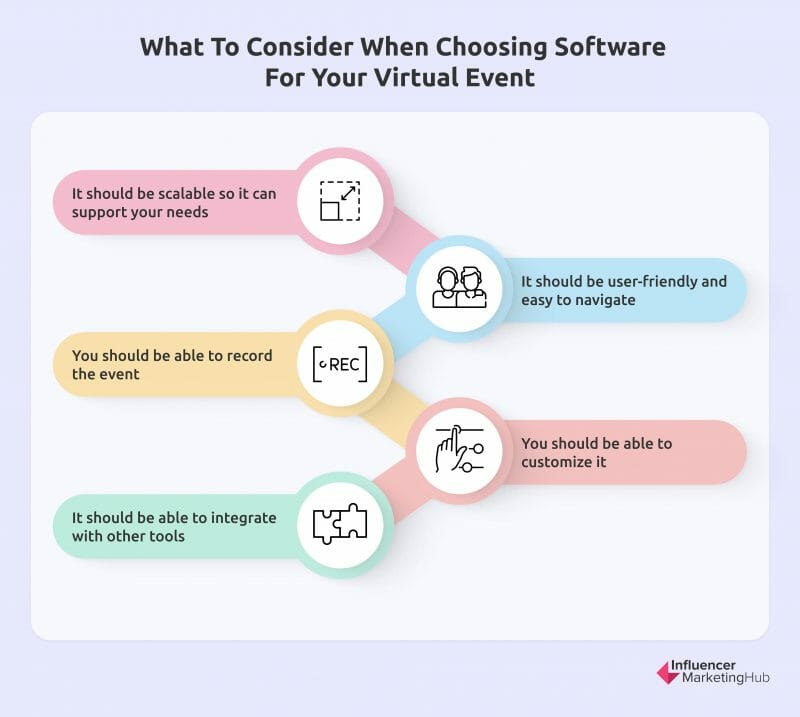
- It should be scalable so it can support your needs even if you need to host larger events.
- It should be user-friendly and easy to navigate so everyone in your team can use it without hassle. Moreover, this is an important consideration if you often intend to invite third-party co-hosts and interviewees.
- You should be able to record the event–whether it’s for internal records or if you want to make the event available to watch on-demand.
- You should be able to customize it so you can create an event that’s tailored to your needs. For example, the option to enable or disable chat is something you’d want to consider. Some platforms also come with interactive features that allow you to conduct polls, which can be great for boosting audience interaction.
- It should be able to integrate with other tools such as ones to collect attendee data or send follow-up marketing emails.
Some of the leading virtual event platforms currently in the market include Hoppier and Hopin. Additionally, you have plenty of other options to choose from. Make sure you’re considering whether you want to host a networking event, a virtual conference, or a team-building event. This will help you decide on the best platform to host your event.

Source: hopin.com
9 Steps to Host a Virtual Event
You have some idea of what virtual event to host and how to choose the right platform. Now the next step is to figure out the actual steps for hosting a virtual event. Here’s what you need to do.
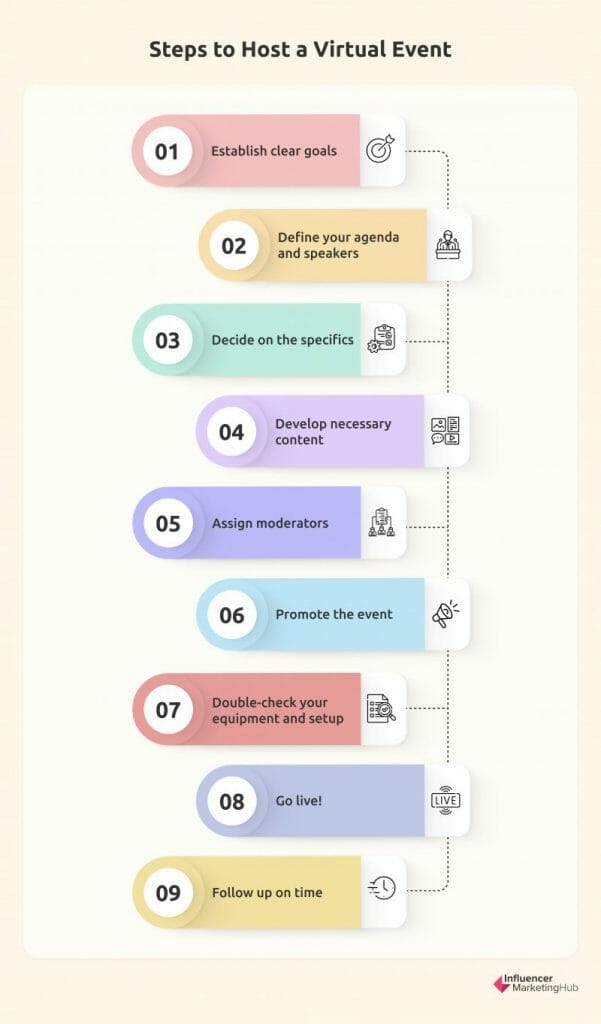
Step 1: Establish clear goals
Like any other event or campaign, start with a clear goal. What do you want to achieve through this virtual event? Do you want to bring more awareness for your brand? Maybe you want to generate buzz for an upcoming release or perhaps you want to drive newsletter signups?
Whatever the end goal is, start by clearly outlining it. Then you can convert the outline into a SMART goal–one that’s specific, measurable, attainable, relevant, and time-bound. For example, if you want to use the virtual event to drive newsletter signups, you could define your goal as: To increase newsletter signups by 5x within one month of launching the event.
Having a clear goal defined early on will give you a better sense of direction for planning the event. Moreover, it’s also essential for measuring the impact of the event.
Step 2: Define your agenda and speakers
What will the event be about? While virtual events can be about anything, it’s important to clearly outline the topic to focus on for a specific event. That way, the conversation can follow some sense of direction and attendees can get clear takeaways once the event has ended.
Whether you plan on educating the audience, providing tips and tricks, or sharing some industry insights–make sure to decide on your agenda early on. This is also essential for planning the speakers for your event. Some brands may host virtual events with in-house experts as speakers while others may want to invite third-party experts to discuss the topic or answer interview questions.
Step 3: Decide on the specifics
Now comes the fun part–deciding on the specifics of the event. This includes details such as the type of event and the duration of the event. Depending on where the event will take place, you may even need to decide on a virtual event platform to use.
The event timing is one crucial element that needs to be strategically planned. If you’re expecting people from different states or different parts of the world to attend, you’ll have to keep in mind the time zone differences and plan the timing accordingly.
For example, the Influencer Marketing Hub Live event is scheduled to take place at 9 am PDT. This timing is generally suitable across different time zones. For example, it’ll be around 9:30 pm for someone living in India, while someone in Norway could tune in at around 6 pm local time.
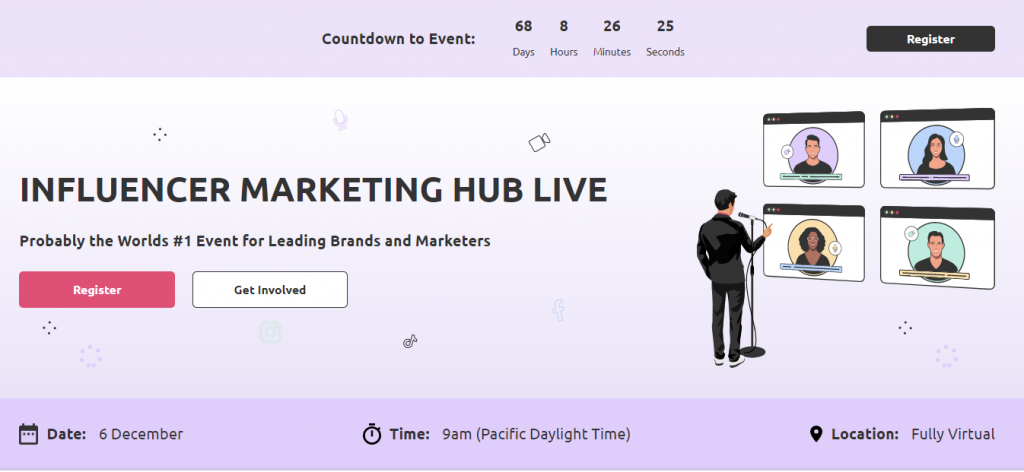
Source: influencermarketinghub.com
Step 4: Develop necessary content
Many virtual events require corresponding content. For starters, you’ll need promotional content to help market the event via email and social media. This would ideally be original graphics that highlight the agenda, timing, and speakers.
Additionally, some types of events will also require in-event graphics to elaborate points and steps. Presentation materials and infographics are often necessary. Make sure you have everything ready before your event goes live.
Step 5: Assign moderators
Reminder: People aren’t always nice, especially not on the internet where they don’t have in-person interactions. Virtual events are at risk of spammers and trolls who might try to disrupt things. This could take a toll on the attendee experience unless you keep it in check. In addition, things could get out of hand pretty quickly if some of your attendees don’t see eye-to-eye.
As such, it’s important to have a few moderators assigned so they can quickly take control of the situation. They may need to kick out and block certain attendees or even disable the chat window in some scenarios.
Step 6: Promote the event
Event promotion is everything! Remember that the success of your virtual event largely depends on how many people attend it. So, you have to get as many people as possible to attend it.
This means promoting the event across multiple channels–through email, social media, and any other marketing channel you may be using. You might even want to invest in paid advertising to get the event in front of even more people. For example, HeyGrowth promoted the following post announcing their Epic Web3 x HUMANS event and launched a targeted Facebook ad campaign.
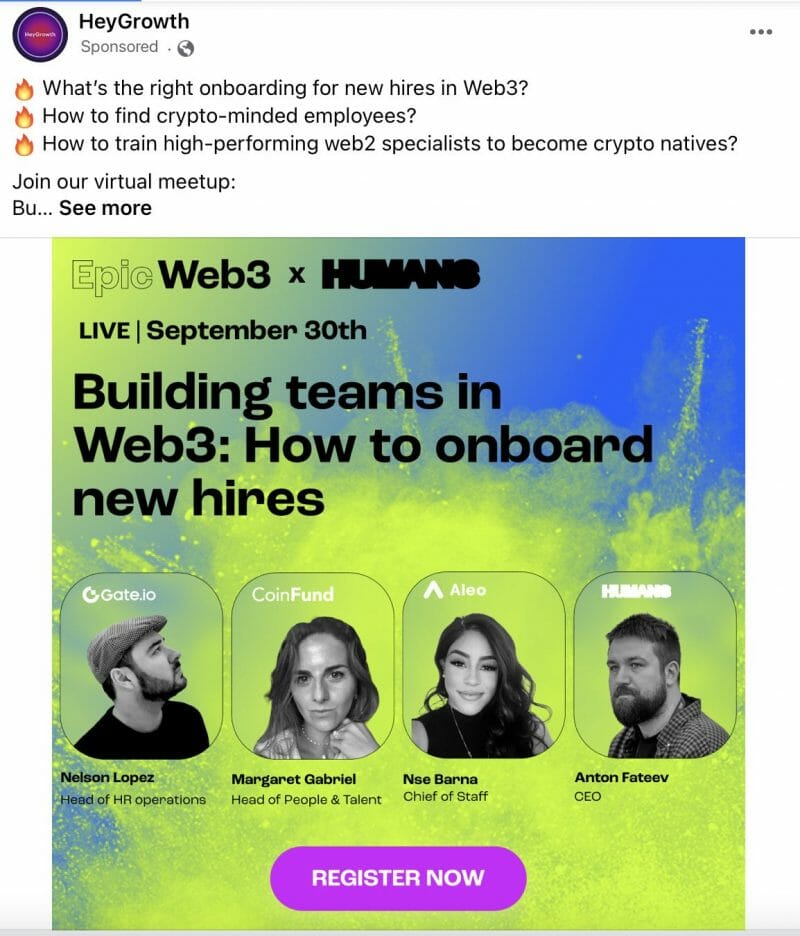
Source: facebook.com
Step 7: Double-check your equipment and setup
For your live event to go seamlessly, your audio and video quality should be top-notch. On top of this, you have to ensure minimal background noise and network disruptions so you can get the message across clearly. So, before you’re ready to go live, don’t forget to double-check your setup and your equipment.
Make sure your background isn’t too distracting so people can focus on the actual discussion. Test the audio, video, and connectivity to ensure that everything’s working optimally. You’d want to give it a test drive by going live with just a few internal team members. This will help you identify any possible issues and fix them before the day of the event.
By testing everything beforehand, you can avoid unexpected delays due to technological issues. You’ll be able to ensure that the virtual event starts on time with minimal delays.
Step 8: Go live!
Once you have everything set up, it’s time to go live. Be punctual and start the event exactly when you say you would. This is important to maintain a professional brand image and establish credibility with your audience. You don’t want to keep them waiting too long due to unexpected glitches.
During the event, be prepared to engage your audience. You could also have a dedicated team member respond to messages in the chat or troubleshoot any issues that attendees might be experiencing. This will ensure that the event runs smoothly and with minimal problems along the way.
Step 9: Follow up on time
After your event has ended, be sure to follow up with your audience. Send them follow-up emails thanking them for their participation. You could even include surveys and questions to collect feedback about the event. The insights from this feedback could then inform your future virtual events.
Prepare for Virtual Event Success
Now you have all the information you need to start planning your next virtual event. Follow the steps and best practices provided above to host a successful virtual event for your brand. Don’t forget to collect valuable attendee data so you can use it to inform your next event and keep optimizing.
Frequently Asked Questions
What do you mean by virtual event?
Virtual events are exactly as the name suggests–they’re events that take place online.
How does a virtual event work?
A virtual event works by gathering a community of people to enjoy a shared experience or engage on a particular topic through virtual channels.
What are the benefits of virtual events?
Virtual events are fairly inexpensive to host. Plus, they also help to gather people from different time zones, thus increasing your reach.
How do virtual events make money?
Virtual events can make money through ticket sales, ad spots, and merchandise sales.
How do you make a virtual event engaging?
You can make a virtual event engaging creating opportunities for interaction such as quizzes, polls, voting, etc.

